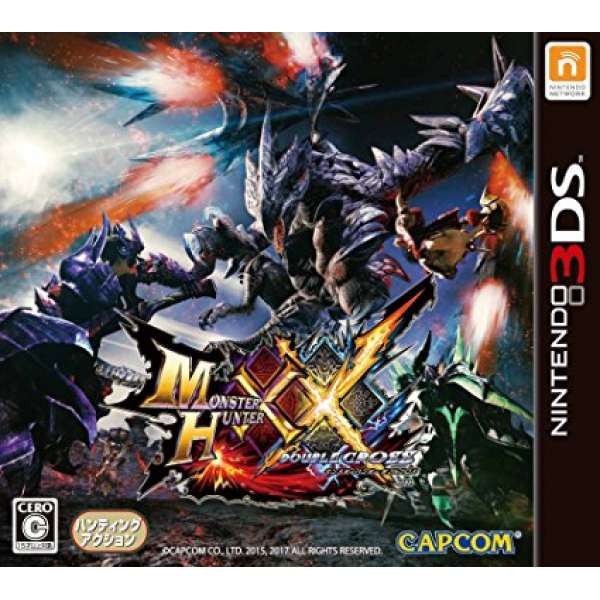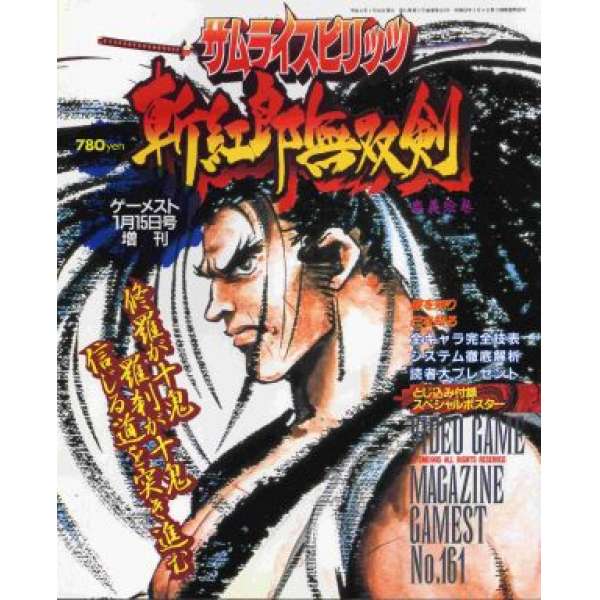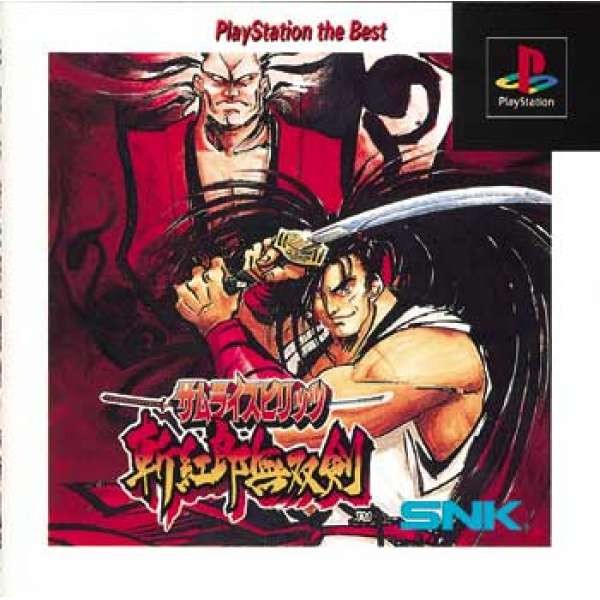侍魂 斬紅郎無雙劍 (無書盒)
1995年,SNK在《侍魂》和《真侍魂》兩作取得成功之後,推出第三款作品《侍魂 3:斬紅郎無雙劍》。這一作在系列中格外特殊,它不僅全面重新檢視遊戲風格,甚至在主角設定、系統機制和美術氣氛上都進行大幅更新。作品在日本常被玩家稱為「斬サム」,既是系列的重要分水嶺,又因其極度狂暴的攻擊力和失衡的對戰體驗而聞名,成為格鬥遊戲史上最具爭議與話題性的作品之一。
故事背景環繞名為「壬無月斬紅郎」的男子展開。他被世人稱為「鬼」,因為他四處屠村,殺戮成性,刀下無人生還。然而某日,他在一個村子裡放過一名嬰兒。沒有人知道他為何失手,但自此之後,斬紅郎開始只獵殺「持刀之人」,彷彿那個嬰兒喚醒某種無法言說的禁忌。數年後,日本各地的武士、忍者與劍客紛紛行動,雖然每個人的目的與背景各異,但他們心中燃燒著相同的目標——挑戰「鬼」壬無月斬紅郎。本作首次改變主角設定,不再以霸王丸為核心,而是引入全新少年角色「緋雨閑丸」作為主視角,象徵SNK嘗試為系列重新定位。
在美術與氛圍上,比前兩作更陰鬱、壓抑,幾乎完全拋棄早期較輕鬆的舞台風格,舞台集中在日本本土,濃厚的武士道和血腥氣息貫穿全場。角色方面,前作的人氣角色如霸王丸、橘右京、半藏、加爾福特與狂死郎仍有登場,但許多較為輕鬆或怪誕的角色被移除,取而代之的是更具個性與危險感的新角色。緋雨閑丸為失憶少年,使用油紙傘與小太刀戰鬥;骸羅則是狂氣十足的花諷院一族殺手,擅長殘虐型必殺技;首斬破沙羅是外型與行為兼具變態色彩的殺人魔;斬紅郎則作為故事主Boss,擁有驚人的力量與致命攻擊。此外,天草四郎時貞首次成為正規可操作角色,而《真侍魂》的莉姆露露也正式加入玩家陣容。
在操作與系統方面,進行大膽革新。按鍵設計上,前兩作以「弱 + 中 = 強」的組合方式發動攻擊,而《斬紅郎無雙劍》將強斬獨立為一個按鍵,並將腳技統一為單一按鍵,配合方向鍵變化,使攻擊輸出更直接、節奏感更強。每名角色還擁有兩種性格模式——修羅與羅刹,前者偏正統,接近前作風格;後者招式詭異且攻擊力更高,帶來截然不同的玩法。此外,本作引入三種「劍質」選項:劍客、劍豪與劍聖,作為自我難度選擇系統。劍聖模式雖無防禦能力,但攻擊力與怒氣增幅極高,成為高風險高速殺戮模式。
怒氣系統也進行改動,當體力掉至三分之一以下時會直接進入永怒狀態,攻擊力暴增並可無限使用超必殺技,瞬間爆發力遠超前作。此外,空中防禦異常強大,空中技與部分地面技皆可防禦且硬直極低,使傳統制空戰幾乎消失。還可使用見切り與回り込み系統進行閃避與繞背,這導致部分角色可以反覆利用背後連段進行極具威脅性的連擊。
最廣為人知的特點,不僅在於系統創新,更在於其失衡的戰鬥設計。幾乎所有角色都可以透過背後連段與取消技形成永久連段,敵人幾乎無法逃脫,如羅刹霸王丸可以持續旋風波加中斬連擊,而莉姆露露可用背後中斬接冰柱連打,許多連段能直接擊殺對手。攻擊力與怒氣系統的設計,使戰鬥極度暴力,也增加比前作更高的爆發力。
總體而言,《侍魂 3:斬紅郎無雙劍》是系列中一次大膽的實驗,將遊戲的陰鬱風格、極端平衡與高自由度連段系統結合,呈現出一種既危險又迷人的格鬥體驗。儘管因平衡問題備受爭議,但其創新角色設計、陰沉美術風格與快節奏戰鬥,使它在格鬥遊戲歷史中佔有獨特且不可忽視的位置,並成為許多玩家眼中最具話題性的一作。
In 1995, after the successes of Samurai Shodown and Samurai Shodown II, SNK released the third installment in the series, Samurai Shodown 3: Blades of Blood. This entry is particularly notable within the series because it completely re-examined the game’s style, updating the protagonist, system mechanics, and artistic atmosphere. In Japan, it is commonly referred to by fans as “Zan-Sam.” The game became both a critical turning point for the series and one of the most controversial and talked-about fighting games in history due to its extremely aggressive attack power and highly unbalanced combat experience.
The story revolves around a man named Mizunazuki Zan-Kuro. Known to the world as a “demon,” he roams the land slaughtering villages indiscriminately, leaving no survivors. One day, however, he spares an infant in a village for reasons unknown. From that moment on, Zan-Kuro only targets those who wield weapons, as if the infant had awakened some forbidden force within him. Years later, samurai, ninja, and swordsmen across Japan begin moving toward a common objective. Although their motivations and backgrounds differ, they all share the same goal: to challenge the “demon” Mizunazuki Zan-Kuro. This installment marks the first time the series shifted its protagonist, replacing Haohmaru with a new young character, Shizuka Shizumaru, symbolizing SNK’s attempt to redefine the series’ focus.
Visually and atmospherically, Samurai Shodown 3 is darker and more oppressive than its predecessors, almost completely abandoning the lighter tone of earlier stages. The game is set entirely within Japan, infused with samurai aesthetics and a blood-soaked ambiance. Returning popular characters such as Haohmaru, Ukyo Tachibana, Hanzo Hattori, Galford, and Kyoshiro maintain their presence, but many of the lighter or more whimsical characters are removed, replaced by stronger, more dangerous new faces. Shizuka Shizumaru, an amnesiac boy, wields a paper umbrella and short sword, seemingly harboring mysterious power. Kagero is a crazed assassin from the Hanagouin clan, specializing in brutal finishing moves. Kubikiri Basara is a psychotic murderer with bizarre movements and appearance, while Zan-Kuro, the story’s main boss, possesses incredible strength and lethal attacks. Additionally, Amakusa Shiro Tokisada becomes a fully playable character for the first time, and Rimururu, formerly a minor character in Samurai Shodown II, is officially added to the roster.
The game’s mechanics underwent bold innovations. The previous system, where “weak + medium attacks = strong attack,” was replaced: weak slash (A), medium slash (B), strong slash (C), and kick (D), with directional inputs modifying the kicks. This made attack output more direct and impactful, while the strong slash gained a more prominent, independent presence. Each character also has two distinct modes—Shura and Rasho. Shura maintains a more traditional playstyle akin to previous games, while Rasho offers unconventional and more violent movesets, creating entirely different gameplay dynamics. The game also introduced three “sword quality” options—Kenshi, Kengo, and Kensei—serving as a self-adjusted difficulty system. Kensei mode, though lacking defensive capabilities, boosts attack power and rage accumulation to extreme levels, effectively creating a high-risk, high-speed killing mode.
The rage system was revamped: when a character’s health falls below one-third, they enter an “eternal rage” state, drastically increasing attack power and allowing unlimited use of super moves, producing explosive reversals far beyond previous entries. Air defense became extraordinarily strong, allowing airborne moves and some ground attacks to be blocked with minimal recovery time, virtually eliminating traditional air control strategies. Players can also utilize the parry and sidestep systems to dodge or maneuver behind opponents, which enables certain characters to exploit infinite back-combo chains, creating devastating attacks.
Samurai Shodown 3 is perhaps most infamous for its extreme imbalance. Nearly all characters can perform repeated combo chains using back attacks and cancel techniques, leaving opponents virtually helpless. For example, Shura Haohmaru can continuously chain his whirlwind slash into medium attacks, while Rimururu can combo back attacks into consecutive ice pillar hits, often resulting in instant kills. The combination of powerful attacks and the rage system makes combat extremely violent and explosive compared to earlier titles.
Overall, Samurai Shodown 3: Blades of Blood represents a bold experiment within the series, blending a darker visual tone with extreme balance anomalies and highly flexible combo systems, delivering a combat experience that is simultaneously dangerous and captivating. Despite controversy over its balance, its innovative character design, brooding artistic style, and fast-paced combat cement its unique and unmissable place in fighting game history, making it one of the most talked-about entries in the eyes of many players.
運費計算方式:
貨款滿1000元運費外加90元
貨款1000以下:買1件運費外加 60元,買2件運費外加 70元,
買3件運費外加 80元 ,買4件運費外加 90元
貨到付款外加30元手續費
外島及大陸地區運費另計
付款方式:
線上刷卡:本站採用Paypal線上刷卡
虛擬帳號匯款:屬於您專屬的虛擬帳戶,方便站長查帳使用,本站強力推薦
實體ATM匯款:請將匯款帳號記錄下來至各大銀行ATM提款機轉帳
超商條碼繳費:請列印本站提供的條碼至四大超商繳費
線上轉帳:透過玉山銀行線上ATM轉帳(此系統只支援IE瀏覽器)
貨到付款:本站採用黑貓宅急便貨到付款
其他注意事項:
如需購買線上點數卡請直接跟站長連絡,本站不提供點數卡的線上付款
-
侍魂 斬紅郎無雙劍 (無書盒)
- 定 價: 33,600円
- 售 價: 0.00
- 庫存量: 0 套
- 已賣出: 0 套
 人氣指數: 0.6 / 6 顆星
人氣指數: 0.6 / 6 顆星 -
魔物獵人 XX
- 定 價: 6,264円
- 售 價: 0.00
- 庫存量: 0 套
- 已賣出: 0 套
 人氣指數: 0.2 / 6 顆星
人氣指數: 0.2 / 6 顆星 -
北美版 星際大戰:原力對決2 GREATEST HITS
- 定 價:
- 售 價: 0.00
- 庫存量: 0 套
- 已賣出: 0 套
 人氣指數: 0.6 / 6 顆星
人氣指數: 0.6 / 6 顆星









